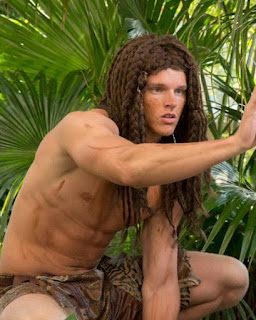Gross! There wouldn't be any same-sex plotlines for 30 years, so they were occupied entirely by the heterosexist "true love between a man and a woman" mantra.
And it would be 20 years before the shirts dropped and soap hunks were regularly put on display.
And they always made you feel guilty for watching.
"Like sands through the hourglass, so are the days of our lives."
We don't have much time on Earth. Better stop wasting time on soap operas and get busy with something useful!
But in 1968 when my friends and I began gathering in front of the tv every afternoon to watch Dark Shadows at 3:00, we sometimes stayed put for the new soap opera One Life to Live -- the only other choices were stupid game shows.
He found "true love" with town heiress Meredith, though her father disapproved of the match. Shortly after they married and she gave birth to twins, she was shot and killed by a burglar, and Larry moved on to a new "true love."
Meanwhile, Meredith's uptight sister Vicki developed a split personality, becoming the funloving Nikki. While slumming, she hooked up with muscular truck driver Vinnie (Antony Ponzini), Larry's working-class brother.
No class distinctions in Llanview!
Antony Ponzini (1933-2002) was a major crush of my childhood, with his dark curly hair, bronze skin, classic Mediterranean features, and muscular build. I'd choose him over the whitebread Larry Wolek any day.
But then Vicki was cured and decided to marry Vinnie's best friend, newspaper reporter Joe Riley (gay actor Lee Patterson who starred with Van Williams, left, in the homoerotic Surfside Six).
How did this incessant, absurdly exaggerated search for heterosexist "true love" fade-out-kiss resonate with gay kids?
1. Every heterosexual relationship played out against a background of same-sex relationships. Larry and Vinnie discuss their desires for Meredith and Nikki, respectively. Vinnie and Joe discuss their desires for Nikki and Vicki, respectively.
2. Heterosexual relationships are doomed. In a week, or a month, or a couple of years, your "true love" will die or fall in love with someone else. But same-sex bonds are permanent.
We stopped watching in 1971, when Dark Shadows ended. But Mom remained a fan for thirty more years of diseases, infidelities, and fade-out-kisses, and, eventually, when Dan Gauthier joined the cast, gay subtexts.




























